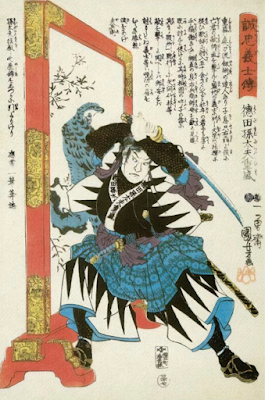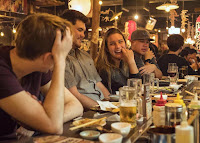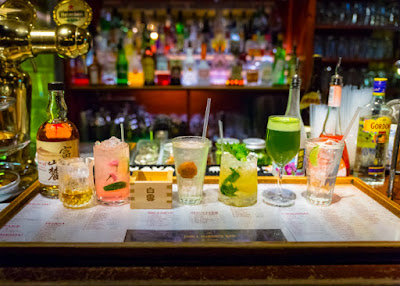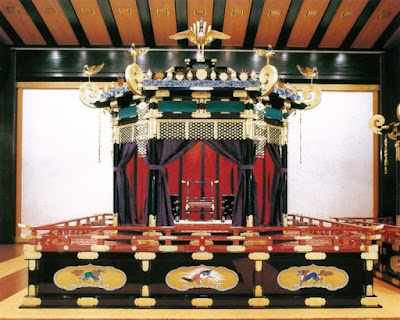Ukiyo-e is a style of Japanese art that flourished during the Edo period (1603-1868) in Japan. The artists of this traditional art form produce woodblock prints and paintings of beautiful landscapes, scenes from history and folk tales, samurai warriors, beautiful women, kabuki actors and sumo wrestlers to name just a few.
Today's guest post is from
Rising Sun Prints, an online store that brings a sense of Japan's timeless beauty to your home.
INTRODUCING RISING SUN PRINTS: OUR STORY AND PRODUCTS
“Every room and every soul is better with art.”
OUR STORY
Rising Sun Prints’ mission is to help lovers of Japanese culture live a more artful life, and to conserve and share the wonderful works of the Japanese art (Ukiyo-e) masters.
In the words of our founder, Jack Jenkins:
"I felt moved by the transcendent beauty of the Ukiyo-e masters, and a desire to make these works known and available.
In the art-form’s heyday, Ukiyo-e were mass-produced for the general public, costing about as much as a bowl of rice. That way, anyone could enjoy a famous view of a distant land, or their home city.
Paintings were for the wealthy social elite, the aristocrats. Ukiyo-e prints were made so that everyone could enjoy the masterpieces of the renowned artists of the day, like Hokusai or Kunisada.
Nowadays, you'll need a spare $10,000 to compete against collectors in auctions, if you want a faded, probably damaged Hokusai print. But in the spirit of the original Ukiyo-e publishers, at Rising Sun Prints we’re making Ukiyo-e accessible to all."
- Jack Jenkins, Founder
With our curated collections of stunning prints, we offer anyone the opportunity to bring a fragment of Japan’s timeless beauty into their home. Our team of enthusiastic art lovers creates articles dedicated to renowned ukiyo-e artists, genre specifics and Japanese culture in general as well as live events and documentaries to grow our community and help them appreciate and discover Japanese artists and their life’s work.
OUR PRODUCTS
We offer collections of ukiyo-e artworks from various genres. The term ‘ukiyo-e’ refers to prints (and sometimes paintings) made in Japan within the 17th, 18th and 19th centuries. These were made using the technique of woodblock printing - where the design would be carved out of cherry wood and printed onto handmade paper, allowing multiples in the thousands to be produced. The subject matter of the artworks commonly varied around what was popular within the pleasure districts, for instance sumo wrestling, kabuki theatre or geisha, but inspiration also arose from the landscapes, warriors, eroticism and legends that formed Japan’s rich culture.
Landscapes
 |
| “Starry Night at Miyajima Shrine” - Hasui, 1928 |
Landscapes were a common genre in ukiyo-e. At the time, Japanese people wanted to view images of travel because they themselves were unable to do so, due to the strict political landscape. But Japanese people also had a deep, spiritual love and respect for nature, relishing in its beauty. We have mesmerising works by some of the most famous landscape artists, including Hokusai, Hiroshige and Hasui.
Warriors, Myths and Legends
 |
| “Tokuda Magodayu Shigemori” - Kuniyoshi, 1947-48 |
Warriors, Myths and Legends were another much-loved element of Japanese culture. They were usually tales of the adventures of: samurai (military noblemen), ronin (samurai without masters) and otokodate (commonly known as ‘street knights’). Rising Sun Prints honors Kuniyoshi's legacy as one of the last masters of ukiyo-e printmaking, and the leading model of Bushido values in Japanese art. This collection of majestic prints is a tribute to his mastery, skill and display of warrior virtue.
Beauty Prints
 |
| “After washing her hair” - Ito, 1936 |
Beauty Prints (Bijin-ga) was one of the most popular forms of ukiyo-e. They depicted the beauties of the day: the courtesans and geisha of the pleasure districts. The artworks portrayed an idealised, traditional interpretation of female beauty. They were also the main instigator of fashion and styles within hair, make-up and clothes. Visitors of our website have the opportunity to acquire wonderful pieces by Ito, Yoshitoshi, Utamaru, Harunobu, Chikanobu and Eisen.
Birds & Flowers
 |
| “Cranes on a snow-covered pine tree” - Hokusai, 1834 |
Birds and Flowers (Kacho-e) were exquisite displays of the natural world - of which the Japanese had the utmost respect for. Many images are embedded with metaphorical and poetic meanings, such as cherry blossoms: which can represent a precious but transient life. Our product range includes many of Hokusai and Hiroshige’s masterpieces where they employ their artistic talent to portray the unique beauty of Japan’s nature.
Erotic Prints
 |
| “The Dream of the Fisherman’s Wife” - Hokusai, 1814 |
Erotic Prints (Shunga) were artworks that portrayed sexually exciting scenes. Unlike many Western cultures, sensual pleasures were considered to be a sacred part of Japanese culture and were not frowned upon in religion. Types of shunga scenes can range from the flirtatious showing of a woman’s neck to multiple couples engaging in exposed coitus. Our collection presents artworks by Utamaru, Eisen, Kiyonaga, Kunisada and Hokusai, the most well-known being “The Dream of the Fisherman’s Wife”, which has become Hokusai’s best known shunga print and has had a massive influence on Japanese culture.
Kabuki Actor Prints
 |
| “Ichikawa Sadanji as Fukashichi the fishmonger” - Kunichika, 1883 |
Kabuki Actor Prints (Yakusha-e) were one of the most popular forms of ukiyo-e. As the theatre art of kabuki was so actor-centred, the heroes and villains of the plays, and the actors who played them, became celebrities. Much like the famous actors of our time, the Japanese public wanted to display images of them in their homes. We have an amazing selection of highlights from masters of the genre: Kunisada, Kunichika and the enigmatic innovator, Sharaku.
Supernatural Prints
 |
| “The ghost of Kohada Koheiji” - Hokusai, 1831 |
Supernatural Prints (Yōkai) covered everything from ghost, to demon to strange apparition. Japan’s history is rich with folklore, the exciting and scary stories of spirits and creatures that brought both good and bad fortune. Originally these beings were incredibly feared, but after being so heavily illustrated in ukiyo-e, much of the belief in yōkai has disappeared. Our community can enjoy a gorgeous collection of Yōkai prints by the great Hokusai as well as Kuniyoshi who specialized in the area.
You can find your own reminder of Japan’s captivating culture on our website, where masterpieces of the ukiyo-e genre transcend time!
Rising Sun Prints Website
 |
| The Great Wave |








































